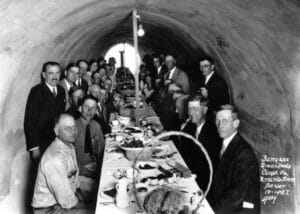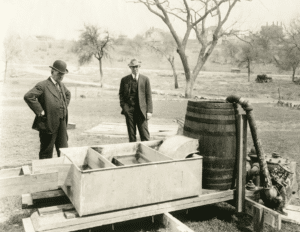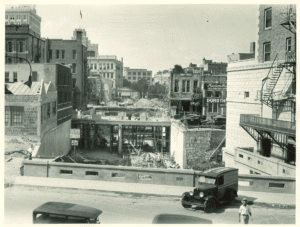The 1920s: Mr. Freese, Mr. Nichols and the Riverwalk
After aiding a foreign community in resolving a water crisis, Major John Hawley, the founder of Freese and Nichols, returned to the United States to apply his wartime knowledge in Breckenridge, Texas. The town urgently required a new waterworks system.
In the subsequent decade, the firm expanded its team, undertook numerous projects, and made a significant impact on various communities in the region.
Hawley and Sands

In June 1921, Hawley joined practices with Edward E. Sands from Houston to establish the Hawley & Sands partnership, with separate offices in Fort Worth and Houston. The firm focused on designing sewage treatment plants. In 1922, they were drafting plans for Fort Worth’s inaugural sewage disposal plant, which commenced operations in April 1924.
From 1921 to 1923, Hawley & Sands designed and oversaw the construction of water purification and sewage disposal facilities in Breckenridge, Fort Worth, Lubbock, and Sweetwater, Texas. In collaboration with Robert J. Cummins, a consulting engineer from Houston, Sands also drafted plans for a new harbor and port at Corpus Christi. This multimillion-dollar project was officially inaugurated in September 1926, following Sands’ untimely death in October 1923 at the age of 46. During the mid-1920s, Hawley’s office also designed a modern rapid sand filtration plant for Beaumont and a water supply dam for Comanche, Texas. Additionally, in 1924-25, the Hawley firm carried out extensive work for Lubbock as part of a large municipal improvement program.
Hawley and Freese
Simon Wilke Freese, described by Major Hawley’s brother as a “remarkable young man and one of the state’s upcoming engineers,” joined Major Hawley’s team on January 2, 1922.

Despite being just 21, Freese had several years of construction experience, as building was the Freese family business. Simon Freese started working in construction as a young boy, carrying water on his father’s projects in East Texas.
Freese took a break from Major Hawley in September 1923 to pursue graduate studies at the University of Cambridge and to research English activated sludge disposal plants. Freese’s interest in activated sludge stemmed from his brief collaboration with Edward Sands. At Cambridge, he had the chance to study the English activated sludge plants and processes, which had been successfully operating in Great Britain for several years and were then the world’s most advanced.
On March 28, 1927, the Major, then 60, signed an agreement with his junior associate, transforming the John B. Hawley firm into the Hawley & Freese partnership.
Hawley, Freese, and Nichols
Eagle Mountain and Bridgeport, both situated northwest of Fort Worth, were the first large dual-purpose reservoirs in the U.S. to offer separate capacities for flood control and water supply. While not unique in their dual-purpose nature, Eagle Mountain and Bridgeport were innovative in providing separate reservoir capacities for their flood control and water supply objectives. In November 1927, the Hawley & Freese firm won a contract to design the dams and supervise their construction.
The construction’s supervising engineer was Marvin C. Nichols, a new professional in Hawley’s office. When the Major and Freese first met him, Nichols was the acting city engineer for Amarillo. During his tenure as city engineer, Nichols oversaw extensive municipal improvements, including brick paving, drainage, sanitary sewers, a sewage pumping station, and an incinerator. However, the most urgent requirement was for a new water supply.
An impounding dam, receiving reservoir, and new well system were developed on Palo Duro Creek to supply 10 million gallons daily. Nichols was the chief construction engineer on the project. It was his first experience with a substantial water supply project, and it sparked a lifelong interest in water resource development. From then on, the challenge of developing and conserving water, the Southwest’s most valuable resource, would be his primary concern as a professional engineer.
Nichols became a partner in 1928.
San Antonio Riverwalk

In 1928, San Antonio became a significant location for Hawley, Freese and Nichols when they opened a branch office there. One of their major tasks in San Antonio was to devise a storm sewer system and design the Great Bend Cut-Off Channel on the San Antonio River. This project was commissioned by the city after a flood swamped the downtown area. The flood protection measures implemented by the firm in 1929 paved the way for one of the city’s most renowned attractions, the “Paseo Del Rio” or San Antonio Riverwalk.
A version of this article was originally published on March 18, 2019.